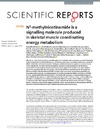Please use this identifier to cite or link to this item:
https://accedacris.ulpgc.es/jspui/handle/10553/44467
| Title: | N1-methylnicotinamide is a signalling molecule produced in skeletal muscle coordinating energy metabolism | Authors: | Ström, Kristoffer Morales-Alamo, David Ottosson, Filip Edlund, Anna Hjort, Line Jörgensen, Sine W. Almgren, Peter Zhou, Yuedan Martin-Rincon, Marcos Ekman, Carl Pérez-López, Alberto Ekström, Ola Perez-Suarez, Ismael Mattiasson, Markus De Pablos-Velasco, Pedro Oskolkov, Nikolay Ahlqvist, Emma Wierup, Nils Eliasson, Lena Vaag, Allan Groop, Leif Stenkula, Karin G. Fernandez, Céline Holmberg, Hans Christer Hansson, Ola Calbet, Jose A. |
UNESCO Clasification: | 32 Ciencias médicas | Issue Date: | 2018 | Project: | Viabilidad y Sostenibilidad Del Adelgazamiento Mediante Tratamiento Intensificado en Pacientes Con Sobrepeso U Obesidad: Mecanismos Neuroendocrinos y Moleculares | Journal: | Scientific Reports | Abstract: | Obesity is a major health problem, and although caloric restriction and exercise are successful strategies to lose adipose tissue in obese individuals, a simultaneous decrease in skeletal muscle mass, negatively effects metabolism and muscle function. To deeper understand molecular events occurring in muscle during weight-loss, we measured the expressional change in human skeletal muscle following a combination of severe caloric restriction and exercise over 4 days in 15 Swedish men. Key metabolic genes were regulated after the intervention, indicating a shift from carbohydrate to fat metabolism. Nicotinamide N-methyltransferase (NNMT) was the most consistently upregulated gene following the energy-deficit exercise. Circulating levels of N-1-methylnicotinamide (MNA), the product of NNMT activity, were doubled after the intervention. The fasting-fed state was an important determinant of plasma MNA levels, peaking at similar to 18 h of fasting and being lowest similar to 3 h after a meal. In culture, MNA was secreted by isolated human myotubes and stimulated lipolysis directly, with no effect on glucagon or insulin secretion. We propose that MNA is a novel myokine that enhances the utilization of energy stores in response to low muscle energy availability. Future research should focus on applying MNA as a biomarker to identify individuals with metabolic disturbances at an early stage. | URI: | https://accedacris.ulpgc.es/handle/10553/41846 | ISSN: | 2045-2322 | DOI: | 10.1038/s41598-018-21099-1 | Source: | Scientific Reports [ISSN 2045-2322], v. 8, article number 3016 |
| Appears in Collections: | Artículos |
SCOPUSTM
Citations
43
checked on Jun 8, 2025
WEB OF SCIENCETM
Citations
42
checked on Jun 8, 2025
Page view(s)
55
checked on Mar 9, 2024
Download(s)
38
checked on Mar 9, 2024
Google ScholarTM
Check
Altmetric
Share
Export metadata
Items in accedaCRIS are protected by copyright, with all rights reserved, unless otherwise indicated.
